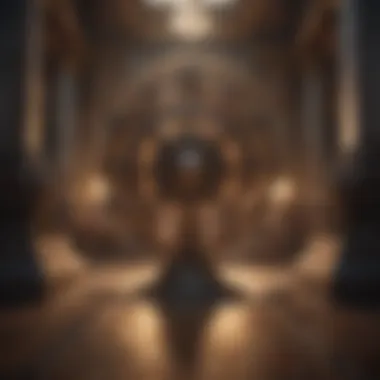Unraveling the Complex Dance of Order and Chaos: An Intellectual Examination


Game Review
Understanding the delicate interplay between order and chaos is akin to mastering the complexities of a well-crafted game; each element influencing the other to shape our experiences. Just like in a meticulously-designed game world, where every decision impacts the outcome, the dynamic equilibrium between order and chaos plays a pivotal role in various aspects of life and society. Society can be viewed as a vast gaming universe, where order provides structure and predictability, while chaos injects spontaneity and uncertainty. It's this symphony of order and chaos that forms the backbone of our existence, much like the intricate mechanics of a captivating game.
Tips and Tricks
Embarking on a journey to explore the balance between order and chaos requires adept strategies and nuanced walkthroughs, much like navigating through challenging levels in a game. Delving deeper into the intricacies of this balance demands a keen eye for hidden secrets and subtle nuances, reminiscent of uncovering Easter eggs within a game. Just as effective gameplay involves mastering character abilities and customization options, understanding the dynamics of order and chaos entails grasping the underlying principles and adapting to changing circumstances. Like honing one's skills through continuous practice and experimentation in a game, navigating the complexities of life with a high-IQ perspective necessitates a deep understanding of the interplay between order and chaos.
Community Highlights
In the vast gaming community of life, individuals from diverse backgrounds converge to share their unique perspectives on the balance between order and chaos. Much like gaming events and tournaments that bring enthusiasts together, discussions and Q&A sessions provide a platform for exchanging insights and experiences related to these fundamental forces. User-generated content showcases the creative interpretations of individuals grappling with the eternal dichotomy of order and chaos. Just as gaming community influencers shape trends and preferences, individuals navigating the intricacies of life draw inspiration and guidance from those who offer fresh perspectives on this perpetual conundrum.
Game Comparisons
Comparing the interplay between order and chaos to evaluating different game titles sheds light on the nuances and complexities inherent in both arenas. Through a side-by-side analysis of how order and chaos manifest in various situations, players can discern the pros and cons of each approach, much like assessing the strengths and weaknesses of different games. Drawing parallels between player feedback on game mechanics and society's response to ordered systems versus random events offers valuable insights into how individuals perceive and interact with these opposing forces. Suggestions tailored to individual preferences bridge the gap between gaming choices and life decisions, emphasizing the need to find harmony amidst the discord of order and chaos.
Introduction
Defining Order and Chaos
The Concept of Order
The Concept of Order embodies structure and predictability, serving as a fundamental pillar in understanding patterns and systems. Its emphasis on organization and coherence contributes significantly to the overall theme of achieving balance in a chaotic world. The key characteristic of Order lies in its ability to provide a sense of stability and direction, making it a valuable asset for navigating through uncertainty. While Order fosters clarity and efficiency, its rigidity can limit adaptability in situations requiring flexibility.
The Concept of Chaos
Chaos, on the other hand, represents unpredictability and disruption, challenging conventional norms and inviting innovation. The essence of Chaos lies in its capacity to spark creativity and change, offering a dynamic contrast to the predictability of Order. Embracing Chaos in this context can lead to breakthroughs and novel approaches, bringing about new perspectives and solutions. However, excessive Chaos may result in instability and disarray, making finding the right balance crucial in harnessing its potential.
Historical Perspectives
Ancient Philosophical Views
Ancient philosophical views on order and chaos have laid the groundwork for understanding the complexities of human existence. These perspectives often emphasized harmonizing opposite forces to attain equilibrium, mirroring the delicate dance between order and chaos. The unique feature of ancient philosophical views lies in their deep-rooted connection to spiritual and existential inquiries, offering timeless wisdom that transcends temporal boundaries.


Modern Interpretations
In contemporary times, modern interpretations of order and chaos have evolved to reflect the rapid changes and complexities of the modern world. These interpretations focus on adapting traditional notions to suit the dynamic nature of society, highlighting the need for resilience and adaptability in the face of uncertainty. The unique feature of modern interpretations is their emphasis on practical applications and real-world implications, bridging the gap between theoretical concepts and everyday realities.
Theoretical Framework
Complexity Theory
Complexity Theory delves into the intricacies of interconnected systems, emphasizing the non-linear interactions that give rise to emergent phenomena. This aspect contributes to a holistic understanding of the intricate balance between order and chaos, shedding light on how complex systems exhibit both patterned behavior and spontaneous fluctuations. The unique feature of Complexity Theory lies in its ability to reconcile seemingly contradictory elements, offering a unified perspective that accounts for the multifaceted nature of reality.
Chaos Theory
Chaos Theory explores the inherent unpredictability and sensitivity to initial conditions within dynamic systems, uncovering the hidden order amidst apparent randomness. This exploration enriches our comprehension of how chaos can coexist with order, bringing forth insights into the underlying structures governing seemingly chaotic phenomena. The unique feature of Chaos Theory is its capacity to reveal underlying patterns and structures within apparently chaotic systems, demonstrating the interconnectedness of order and chaos in the fabric of reality.
The Role of Order in Society
Social Structures and Hierarchies
Impact on Governance
Scrutinizing the impact of Order on Governance reveals a fundamental pillar sustaining societal operations. By instilling definitive structures and hierarchies, governance models embody the essence of orderly conduct and authority delineation. The essence of command and control within this system elucidates the hierarchical nature of power distribution, ensuring oversight and accountability in decision-making processes. This strategic allocation of roles and responsibilities not only streamlines administrative processes but also fortifies the governance framework against chaos and entropy, fostering sustainable progress and social equilibrium amidst uncertainties.
Organizational Dynamics
The intricate tapestry of Order threads through the fabric of organizational dynamics, weaving a narrative of strategic alignments and operational efficiencies. Organizational structures inherently mirror societal hierarchies, embodying a microcosm of governance principles within corporate realms. The hierarchical arrangements within organizations delineate clear reporting lines, functional roles, and decision-making authority, propelling streamlined operations and enhanced productivity. However, these structured dynamics may also engender rigidity and bureaucratic hurdles, potentially impeding adaptability and innovation within organizational ecosystems. Navigating the fine line between structured order and agile flexibility remains a critical challenge for optimizing organizational dynamics amidst the ever-evolving business landscape.
Cultural Norms and Traditions
Stability vs. Innovation
The dichotomy between Stability and Innovation within cultural norms illuminates a compelling narrative of tradition preservation versus progressive evolution. Stability ingrains a sense of continuity and heritage, preserving time-honored practices and foundational beliefs essential for societal cohesion. Conversely, Innovation catalyzes change, propelling societies towards dynamic transformations and adaptive growth. Balancing these contrasting forces ensures a harmonious blend of tradition and progress, fostering cultural resilience and evolutionary advancement. However, an overemphasis on stability may lead to stagnation, hindering innovation and impeding organic societal evolution.
Interplay with Chaos
Unveiling the symbiotic relationship between cultural norms and chaos underscores the catalytic role of disorder in fueling creative expression and paradigm shifts. Chaos serves as a catalyst for innovation, disrupting conventional norms and sparking novel ideas that challenge societal conventions. The interplay between chaos and cultural traditions offers a breeding ground for creativity, inviting cultural reinterpretations and paradigm-shifting revolutions that redefine societal landscapes. Embracing chaos within cultural frameworks initiates a transformative journey towards artistic renaissance and societal rejuvenation, propelling civilizations towards new horizons of creativity and cultural vibrancy.


Embracing Chaos for Creativity
In this pivotal section of the article on Exploring the Balance Between Order and Chaos from a High-IQ Perspective, we delve deep into the significance of embracing chaos for stimulating creativity. The juxtaposition of chaos with creativity unveils a realm where traditional constraints are surpassed, granting space for novel ideas and groundbreaking innovations to flourish. Creativity fueled by chaos transcends the usual norms and boundaries, paving the way for exceptional breakthroughs and evolutionary progress. Recognizing chaos as a catalyst for creativity redefines conventional perspectives and fosters a mindset geared towards unconventional thinking and inventive solutions.
Artistic Expressions
Breaking Conventions
Exploring the facet of breaking conventions within the context of this discourse sheds light on the essence of challenging established norms and paradigms. Breaking conventions serves as a pivotal element in stimulating creativity by disrupting familiar patterns and inviting fresh perspectives. This deliberate act of deviating from the norm ignites a wave of inspiration and innovation, prompting individuals to explore uncharted territories and redefine artistic boundaries. Consequently, breaking conventions not only infuses artistic endeavors with a sense of vitality and originality but also propels artistic expressions towards new heights of creativity.
Exploring Unpredictability
Delving into the realm of unpredictability in artistic pursuits reveals a hidden reservoir of potential waiting to be unleashed. Embracing unpredictability as a creative tool injects a sense of dynamism and spontaneity into artistic creations, infusing them with an aura of intrigue and captivation. By embracing the unexpected twists and turns that unpredictability offers, artists open themselves to a realm of limitless possibilities and unexplored artistic avenues. Navigating the terrain of unpredictability demands a courage to embrace the unknown and a willingness to transcend conventional artistic boundaries, leading to artistic expressions that transcend the commonplace and resonate with profound creativity.
Entrepreneurial Ventures
Innovation in Business
Exploring the realm of innovation in business within the domain of this discussion sheds light on the critical role innovation plays in driving entrepreneurial success. Innovation serves as the lifeblood of businesses, fueling growth and propelling organizations towards sustainable success. By harnessing the power of innovation, businesses can revolutionize their offerings, streamline operations, and gain a competitive edge in the market. Embracing a culture of innovation not only enables businesses to adapt to changing market dynamics but also empowers them to spearhead industry advancements and shape future trends, positioning them as pioneers in their respective domains.
Risk-Taking Mindset
Unpacking the concept of a risk-taking mindset in entrepreneurial ventures uncovers the foundational principles essential for navigating the tumultuous waters of business. A risk-taking mindset entails a willingness to venture beyond the realm of certainty and embrace the unknown with strategic boldness. By daring to take calculated risks, entrepreneurs can seize opportunities, innovate proactively, and chart new territories in the business landscape. Embracing a risk-taking mindset empowers entrepreneurs to transcend limitations, capitalize on emerging trends, and pioneer industry-disruptive strategies, fostering a culture of resilience and adaptability in the face of uncertainties.
Finding Harmony in the Duality
In the intricate exploration of the delicate balance between order and chaos, the topic of Finding Harmony in the Duality emerges as a pivotal aspect. Understanding how to achieve equilibrium between these contrasting forces is crucial in navigating the complexities of life and society. By delving into the nuances of harmonizing order and chaos, this article aims to shed light on the significance of finding a middle ground that fosters stability and innovation. The interplay between stability and flexibility is not merely a theoretical concept but a practical necessity for individuals and societies seeking to adapt and thrive in dynamic environments.
Balancing Stability and Flexibility
Surviving and thriving in an ever-changing world requires a fine balance between stability and flexibility. In the realm of Finding Harmony in the Duality, striking this equilibrium holds the key to sustainable growth and resilience. Embracing change is not just about accepting it but proactively adjusting strategies and mindsets to meet new challenges. The ability to adapt to changing circumstances while maintaining a core foundation of stability is a hallmark of successful individuals and organizations.
Adaptation to Change


Adaptation to Change stands at the forefront of maintaining equilibrium in the face of uncertainty. This adaptive capacity allows entities to evolve, innovate, and survive in tumultuous times. The essence of Adaptation to Change lies in its responsiveness to external shifts, enabling a proactive approach towards future readiness. In the context of this article, the emphasis on Adaptation to Change underscores the importance of staying ahead of the curve amidst evolving circumstances, thereby ensuring relevance and sustainability.
Resilience in Uncertainty
Resilience in Uncertainty plays a crucial role in fortifying the foundations of harmony amidst chaos. Building resilience involves developing the capacity to endure adversity, bounce back from setbacks, and navigate uncharted territories with composure. The resilience exhibited in the face of uncertainty distinguishes those who weather storms from those who succumb to challenges. In the context of this article, resilience serves as a pillar of strength, offering individuals and societies the ability to withstand upheavals and emerge stronger.
Integration of Opposing Forces
The Integration of Opposing Forces encapsulates the essence of harmony between order and chaos, presenting a holistic approach to leveraging the synergies derived from divergent elements. By exploring the complementary nature of these opposing forces, this section underscores the transformative power of integrating seemingly contradictory components.
Synergy of Order and Chaos
The synergy between Order and Chaos exemplifies the fusion of structure and spontaneity, culminating in innovation and growth. This dynamic interplay fosters creativity, adaptability, and progress, showcasing how harnessing the dualities of life can lead to breakthrough outcomes. In this article, the focus on the Synergy of Order and Chaos illustrates the potential for harmonizing seemingly discordant elements to drive positive change and evolution.
Synergistic Growth
Synergistic Growth represents the culmination of harmonizing diverse forces to propel collective advancement. By aligning disparate strengths and perspectives, synergistic growth enables exponential development and collaborative success. The inherent advantages of synergistic growth lie in its capacity to amplify individual contributions, facilitate mutual learning, and maximize overall performance. Within the context of this article, synergistic growth emerges as a beacon of synergized efforts, illustrating how unified endeavors can yield greater results than isolated pursuits.
Conclusion
In this article on exploring the balance between order and chaos from a high-IQ perspective, we have unravelled the intricate interplay between these opposing forces that shape multiple facets of life and society. The thorough analysis presented sheds light on how order and chaos coexist and influence various aspects of existence. By delving into philosophical insights and practical applications, this exploration aims to offer a deep understanding of the dynamic equilibrium between order and chaos. It emphasizes the significance of embracing both order and chaos to achieve harmony and foster creativity and resilience.
Key Takeaways
Dynamic Equilibrium
In the context of this article, dynamic equilibrium plays a pivotal role in balancing order and chaos. This state of balance ensures that neither extreme dominates, leading to adaptability and sustainability in various systems. The key characteristic of dynamic equilibrium is its ability to maintain stability while allowing for flexibility and growth. It serves as a beneficial choice for this article as it highlights the importance of maintaining a constant state of flux to navigate complexities effectively. The unique feature of dynamic equilibrium lies in its ability to foster resilience and innovation while mitigating the risks of stagnation and chaos.
Impact on Decision-Making
The impact of dynamic equilibrium on decision-making processes is profound in the exploration of order and chaos. Decision-making within the framework of dynamic equilibrium involves considering both stability and change, known for its ability to optimize outcomes in uncertain environments. Its key characteristic lies in the balance it strikes between deliberate planning and adaptive responsiveness to changing circumstances. This approach proves beneficial for this article as it underscores the significance of strategic decision-making in the face of evolving challenges. The unique feature of dynamic equilibrium in decision-making lies in its capacity to promote agility and foresight while managing risks effectively.
Future Implications
Navigating Uncertainty
Navigating uncertainty emerges as a crucial aspect in exploring the balance between order and chaos from a high-IQ perspective. This concept involves developing strategies to cope with unpredictability and ambiguity, crucial for making informed decisions in volatile environments. The key characteristic of navigating uncertainty is its emphasis on adaptability and open-mindedness in the face of change. It proves to be a valuable choice for this article as it underscores the significance of being prepared for unexpected disruptions while leveraging uncertainty as a catalyst for growth. The unique feature of navigating uncertainty lies in its potential to foster learning and innovation while minimizing the adverse effects of chaos.
Cultivating Resilience
Cultivating resilience stands out as a critical factor in embracing the balance between order and chaos. Resilience encompasses the capacity to bounce back from adversity, displaying strength and adaptability in the face of challenges. The key characteristic of resilience is its role in enhancing individuals' ability to withstand uncertainty and withstand disruptions. It is a beneficial choice for this article as it highlights the importance of developing coping mechanisms in turbulent times. The unique feature of resilience lies in its potential to promote psychological well-being and sustained performance despite external pressures.







